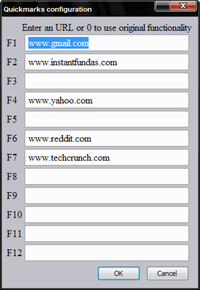The computer keyboard has 12 Function keys at the top numbered from 1 through 12. The purpose of function keys is to provide users with shortcuts to perform specific actions in the operating system or an application. The programmer of an application is free to assign any actions to the function keys as he sees it fit, although some function keys have universal actions. For instance, the F3 key will launch the "Find" or "Search" tool in almost any application while the F5 key reloads a page in any browser. In games you will often find the F5 (or F4) key being used as quick save. It's obvious that the function keys are very useful for creating shortcuts even though most of them are usually left unused, including in Firefox.
 A Firefox extension named Quickmarks, can assign these function keys to specific web addresses turning it into a "quick dial" for opening your bookmarked pages. After you install this addon, click on Tool>Quickmarks settings to open the setting window. Type the URLs of the sites you want to open with the function keys.
A Firefox extension named Quickmarks, can assign these function keys to specific web addresses turning it into a "quick dial" for opening your bookmarked pages. After you install this addon, click on Tool>Quickmarks settings to open the setting window. Type the URLs of the sites you want to open with the function keys.
Now you can open your favorite sites by just a single keystroke. One problem with this addon is that the function keys will cease to perform any other actions other than opening bookmarks. Which means that F5 will stop reloading pages, F11 will no longer make Firefox full screen and F3 will not launch the Find bar, even if you have not assigned any bookmarks to those keys. Most users won't like that, I guess. But Quickmarks is still an experimental addon and there is plenty of room for improvements.

Thanks for the review :)
ReplyDeleteAbout the flaw you mentioned: the text above the text fields clearly states to fill in 0 if you want to use the original functionality of the function key.
Great
ReplyDelete